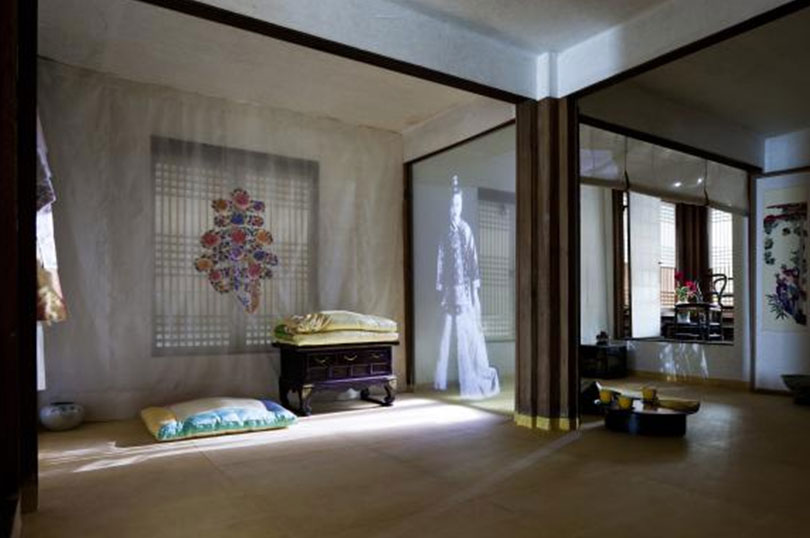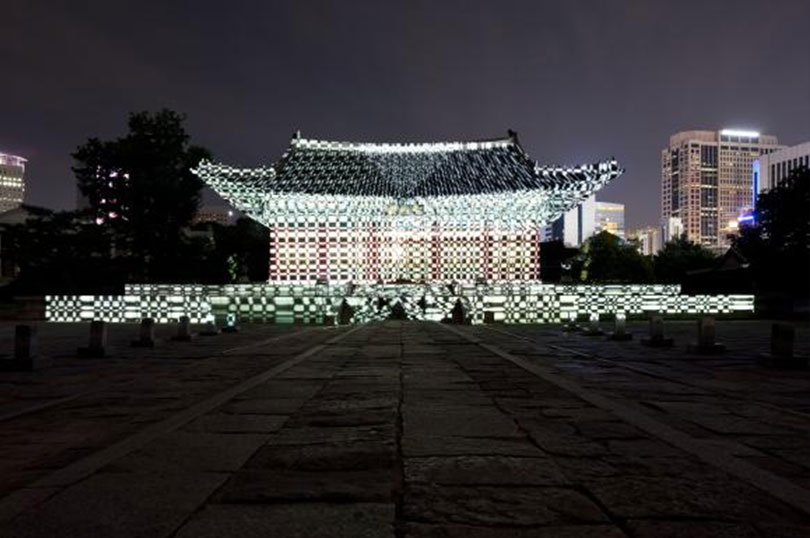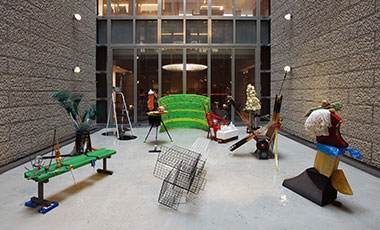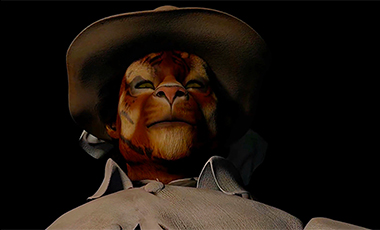In the NovemberArt Talk, we review the 《Deoksugung Project》 (2012.9.19.~12.2, Deoksugung Palace), which has brought a nation-wide sensation through the encounter between Deoksugung and Korean contemporary art. At every place in Deoksugung which has various time layers as a historical site, this art project exhibits various works of Korean contemporary art by diverse creators from diverse fields such as artists, dancers, and so on. As far as the Art Talk is a comer that proposes diverse points of view through cross-criticisms by diverse experts from various fields, we reviewed this project and art works this time with peculiar aspects of diverse critics of various fields, including the curator of the project.
《Deoksugung Project》: Reconciliation between Crash of Time and Scenography
Spirits dwell in the place. The longest and powerful spirit becomes a god as "Teojudaegam (the highest seniority)." Although not seen with our naked eyes, this god dwells with us and tries to alter our memories with deja vu as if he, saying "this is you originally," shows us the mirror in which ourselves are reflected. The image inside of us, which is very familiar but aggravates somewhat unfamiliar discomfort, emerges as a shadow, as a projection, as a warmth and pleasance of the floor, and as a strange sound.
The 《Deoksugung Project》 is an attempt to return something at the site of Deoksugung that all Koreans commonly know, by going upstream like a salmon swimming in time. This ‘something' is the spirit as the main character who (had) dwelt in the palace. With the quite animistic emergence, the space inside and outside the palace is very dramatic in terms of the Shakespearian meaning. Why? For it seems that the apparition of the late king whom Hamlet fears or the ghost of the King Duncan of whom Macbeth is afraid, would appear immediately.
 Traditional Korean Costume Kim Young Seok_Seogeodang, Better Days National Museum of Contemporary Art Korea Commission, 2012
Traditional Korean Costume Kim Young Seok_Seogeodang, Better Days National Museum of Contemporary Art Korea Commission, 2012-We write it as "the apparitional hallucination of Dukhyeongju(Princess Dukhye)," which can be seem, however, to be a literal description at some points.
The ‘style of return' of Kim Young Seok's 'Better Days' is very blunt. The popularized chronological images of Dukhyeongju(Princess Dukhye) are overlapped and her name is called in the nuance of ghosty feeling. Seogeodang, which lost the dwelling function, is not noble enough due to the crowd of viewers, but is sublime enough at a certain moment. In the meantime, Jung Youngdoo's performance expressing King Gojong becomes opened with the simultaneous viewpoints with the help of the video installation showing both the interior and exterior of the palatial space, or both close- and distant-range view. And three sets of ‘Boryo (fancy cushion mattresses)' testify the absence. Memories come out from the calls of time, and for this, either the phenomena of the body or performance should emerge as a fantasy in the space. This is perhaps the very shamanic rent of body. We traditionally call this type of rental body "Momjudaegam."
A palace is a place of resonance, and the every place inside of the Deoksugung proved its excellency as a space for the experience of it. Sung Kiwan's 'Audiorama-Chosun Royal Novel Dictation Project' widened the gap of the senses with the methods of using voices of a professional announcer by reading rare novel texts of Chosun royal family. This is a sort of ways to alter the sense of the text's distance approaching to us with the sense of the tone color's distance. Ha Jihoon's 'Jari' let viewers appreciate the Dancheong (traditional multi-colored paintwork on wooden buildings) of the ceiling, proportion of the door, and the resonance of the sound with the gaze from the sitting point on the chrome gilded chair, as if the artist would decode the potential power of the fine arts in Chosun palaces. Here, a method was adopted that Sung Kiwan's sound abruptly intervenes.
Whereas Ha Jihoon's 'Jari' should takes an attitude of affordance that our bodies become chair-like for us to sit on it, Chung Seoyoung's 'Inwardly, Determine Yourself' makes our gazes adjusted by a multi-angled mirror which enables us to feel the intercultural communication created by the heterogeneous infiltration of Russian stylistic architecture. Ryu Hankil's sound installation work was about to intervene here, but did not seem to operate for some reason.
Choi Sunghun+Park Sunmin
Crystal vs. Decision, National Museum of Contemporary Art Korea, Commission, 2012
- The time is precisely at 18:15 when the materiality as a tacit being inconspicuous started to emit the light.
The 《Deoksugung Project》 conciliates its space with a scenography by the collision of the past and the present time only after darkness begins to fall. Choi Sunghun+Park Sunmin's 'Daystar 1,2' give viewers a feeling of installing condenser with (extra-) ordinary video as if it absorbs lights during the daytime and throws up again during the night until then. And their 'Crystal vs. Decision' suggests tacitly that an important event happens while nobody becomes aware through the open storage of crystal blocks which are not easily conspicuous between the gap of the trees planted on the vacant spot among palatial buildings. Yeesookyung's 'Tear Drop' either seems like the crystallization of healed injury just like a diffusedly reflecting diamond by numerous cuttings, or like an abstract equipment which condenses the 《Deoksugung Project》 as a singular one. More directly, it is self-explaining that the work is a metaphor of the ‘tear' of the history.
 Lyu Jaeha_Junghwajeon, Time, National Museum of Contemporary Art Korea, Commission, 2012
Lyu Jaeha_Junghwajeon, Time, National Museum of Contemporary Art Korea, Commission, 2012-The tragedy of the Junghwajeon, the main building of Gyungwoongung, is visualized in spectacle video images.
For this reason, it is the best time for viewers to enjoy the 《Deoksugung Project》 from about 4pm to 7pm. Because, during this time, the artificial lights begin to bustle with the emergence of the apparition of time, the history, with the extinction of solar light, sounds open our ears, and the resonance of this space presses our body. The half of this effect attributes to the power of the Deoksugung's architectural space. At the end of this time, Lyu Jaeha represents the details of the history filled in every part of the inner side of Deoksugung as a material through the projected lights. It is not to scatter the contour of the Deoksugung but to illuminate more vividly. Nothing is more effective than this dramatic Shakespearian events of conflagration, downfall, ruin, auspiciousness, and tragedy. The sound is also very dramatic. The 《Deoksugung Project》 installs dramatic tools and projects of the Deoksugung, by the Deoksugung, for the Deoksugung through the equipment of ‘time slip.' Freud's occult operated also this time without fail that ‘what is oppressed returns,' but as a matter of fact, I was not fully satisfied witnessing the accomplishment of this occult's the most important category as an one-way traffic whereas enjoying the 《Deoksugung Project》. Because it was not the resurrection of the King Gojong or Dukhyeongju(Prince Dukhye) but a new relationship, a new connection line what should be revived with animism. While we reconciled with the spirits, they die so easily due to such fetishistic hospitality. It is a paradox.
Deoksugung Project viewed by 6 people
The Calling of Memory _ Jung Hyun(Art Critic, Independent Curator)
The inside of time in the eternal rest _ Gu Na-yeon(Art Critic)
I want to go further back in time _ Kim, So-yeon(Theater critic)
《Deoksugung Project》: Contemporary Interpretation on Legacy _ Kim Inhye(Curator, National Museum of Contemporary Art Korea )
《Deoksugung Project》: To get over the Sadness to Pieces _ Sun Seunghye(Professor, Sungkyunkwan University)

Kim Namsoo / Choreography Critic
started his career as a choreography critic by winning the prize for the part of the choreography criticism from the ninth Choreographic Art Prize in 2001. The author has worked until present days as an editor of a performing art magazine Pan since its foundation in 2006 after his former position as an editor of a monthly choreography magazine Mom(Body) in 2003. As a researcher of the Nam June Paik Art Center for three years from 2008 and the chief researcher of the National Theatre Company of Korea in 2011, Kim published Nam June Paik: From Horse to Christo, The Return of Nam June Paik, and so on. He also issued the initial number of the Quarterly Theatricals.


